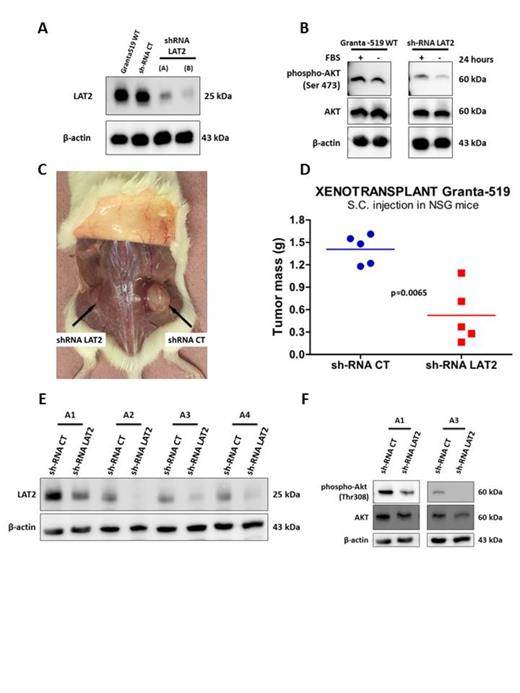Abstract
Introduction: Lipid rafts are highly ordered membrane domains that are enriched in cholesterol and sphingolipids and provide an environment for signal transduction proteins which control cell survival and cell death. Altered raft assembly has been implicated in cancer progression. Alkylphospholipids (APL) inhibit the AKT pathway and induce apoptosis of malignant cells but not of their normal counterparts when used at the same concentration. LAT2 (Linker for activation of T-cells family member 2) is a lipid raft component which is disrupted by APLs in leukemic cells. In the present study we evaluated the effect of perifosine, an APL with anticancer activity in humans, on the LAT2 and AKT pathways using a Mantle Cell Lymphoma (MCL) cell line (Granta-519 cells) as a model. We selected MCL cells to study because AKT is constitutively phosphorylated in this disease.
Methods: We determined whether perifosine induced apoptosis of unmodified Granta-519 cells using flow cytometry, we measured caspase-3 activity with a synthetic peptide and detected cleaved caspases by western blotting. Then, we demonstrated the participation of LAT2 in AKT signaling. We used a stable knockdown of LAT2 (lentiviral sh-RNA). After transduction, Granta-519 cells were selected using 0.5 µg/mL puromycin for 5 days. Stable LAT2 knockdown reduced LAT2 levels by 90% (Figure 1A) and showed impaired AKT phosphorylation in the absence of ligands (Figure 1B).
Results: Perifosine treatment induced apoptosis of Granta-519 cells and the effective dose 50% (ED-50) was 20 μM. Apoptosis was triggered after 6 hours of incubation and activation of the extrinsic and intrinsic pathways of apoptosis was demonstrated. Perifosine decreased LAT2 abundance after 3 hours of treatment, also decreasing its presence in lipid rafts, and led to a decrease in AKT phosphorylation and downstream components of AKT signaling. Moreover, perifosine impaired AKT phosphorylation in the presence of stimuli such as CD40L (330 ng/mL) in Granta-519 cells after a few minutes of incubation, resulting in an effect similar to that of the PI3K inhibitor Wortmannin (1 µM). In vivo studies using Granta-519 subcutaneous xenografts in NSG mice revealed that stable knockdown of LAT2 cells showed reduced tumor growth. sh-RNA CT cells (0.75x106) were injected into the right flank of five mice and the same number of sh-RNA LAT2 cells were injected into the left flank of the same animals. After 3 weeks, the tumor weight (mean + SD) was 0.52 ± 0.37 g for sh-RNA LAT2 tumors compared to 1.41 ± 0.19 g for sh-RNA CT tumors (p=0.0065) (Figure 1C and 1D). The LAT2 content of sh-RNA LAT2 cells and AKT phosphorylation were also reduced (Figure 1E and 1F).
Conclusions: These results demonstrate that LAT2 is an important protein for supporting constitutive AKT phosphorylation/activation and downstream signaling in MCL and suggest that inhibition of LAT2 by APLs may have therapeutic applications.
Acknowledgments: This research was supported by FAPESP, FINEP, and CNPq. C.H.T. received fellowships from FAPESP Proc. No. 13/07675-3. G.A.F. received a fellowship from CNPq Proc. 150126/2014-0. G.A.F. and C.H.T. contributed equally to this work
No relevant conflicts of interest to declare.
Author notes
Asterisk with author names denotes non-ASH members.


This feature is available to Subscribers Only
Sign In or Create an Account Close Modal